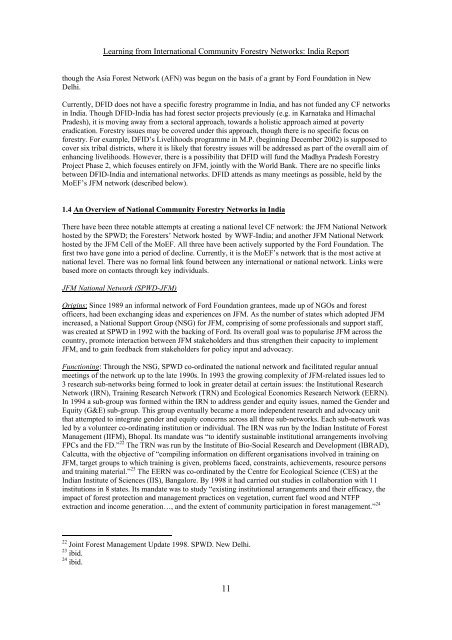Snapshots of International Community Forestry Networks: Country ...
Snapshots of International Community Forestry Networks: Country ...
Snapshots of International Community Forestry Networks: Country ...
Create successful ePaper yourself
Turn your PDF publications into a flip-book with our unique Google optimized e-Paper software.
Learning from <strong>International</strong> <strong>Community</strong> <strong>Forestry</strong> <strong>Networks</strong>: India Report<br />
though the Asia Forest Network (AFN) was begun on the basis <strong>of</strong> a grant by Ford Foundation in New<br />
Delhi.<br />
Currently, DFID does not have a specific forestry programme in India, and has not funded any CF networks<br />
in India. Though DFID-India has had forest sector projects previously (e.g. in Karnataka and Himachal<br />
Pradesh), it is moving away from a sectoral approach, towards a holistic approach aimed at poverty<br />
eradication. <strong>Forestry</strong> issues may be covered under this approach, though there is no specific focus on<br />
forestry. For example, DFID’s Livelihoods programme in M.P. (beginning December 2002) is supposed to<br />
cover six tribal districts, where it is likely that forestry issues will be addressed as part <strong>of</strong> the overall aim <strong>of</strong><br />
enhancing livelihoods. However, there is a possibility that DFID will fund the Madhya Pradesh <strong>Forestry</strong><br />
Project Phase 2, which focuses entirely on JFM, jointly with the World Bank. There are no specific links<br />
between DFID-India and international networks. DFID attends as many meetings as possible, held by the<br />
MoEF’s JFM network (described below).<br />
1.4 An Overview <strong>of</strong> National <strong>Community</strong> <strong>Forestry</strong> <strong>Networks</strong> in India<br />
There have been three notable attempts at creating a national level CF network: the JFM National Network<br />
hosted by the SPWD; the Foresters’ Network hosted by WWF-India; and another JFM National Network<br />
hosted by the JFM Cell <strong>of</strong> the MoEF. All three have been actively supported by the Ford Foundation. The<br />
first two have gone into a period <strong>of</strong> decline. Currently, it is the MoEF’s network that is the most active at<br />
national level. There was no formal link found between any international or national network. Links were<br />
based more on contacts through key individuals.<br />
JFM National Network (SPWD-JFM)<br />
Origins: Since 1989 an informal network <strong>of</strong> Ford Foundation grantees, made up <strong>of</strong> NGOs and forest<br />
<strong>of</strong>ficers, had been exchanging ideas and experiences on JFM. As the number <strong>of</strong> states which adopted JFM<br />
increased, a National Support Group (NSG) for JFM, comprising <strong>of</strong> some pr<strong>of</strong>essionals and support staff,<br />
was created at SPWD in 1992 with the backing <strong>of</strong> Ford. Its overall goal was to popularise JFM across the<br />
country, promote interaction between JFM stakeholders and thus strengthen their capacity to implement<br />
JFM, and to gain feedback from stakeholders for policy input and advocacy.<br />
Functioning: Through the NSG, SPWD co-ordinated the national network and facilitated regular annual<br />
meetings <strong>of</strong> the network up to the late 1990s. In 1993 the growing complexity <strong>of</strong> JFM-related issues led to<br />
3 research sub-networks being formed to look in greater detail at certain issues: the Institutional Research<br />
Network (IRN), Training Research Network (TRN) and Ecological Economics Research Network (EERN).<br />
In 1994 a sub-group was formed within the IRN to address gender and equity issues, named the Gender and<br />
Equity (G&E) sub-group. This group eventually became a more independent research and advocacy unit<br />
that attempted to integrate gender and equity concerns across all three sub-networks. Each sub-network was<br />
led by a volunteer co-ordinating institution or individual. The IRN was run by the Indian Institute <strong>of</strong> Forest<br />
Management (IIFM), Bhopal. Its mandate was “to identify sustainable institutional arrangements involving<br />
FPCs and the FD.” 22 The TRN was run by the Institute <strong>of</strong> Bio-Social Research and Development (IBRAD),<br />
Calcutta, with the objective <strong>of</strong> “compiling information on different organisations involved in training on<br />
JFM, target groups to which training is given, problems faced, constraints, achievements, resource persons<br />
and training material.” 23 The EERN was co-ordinated by the Centre for Ecological Science (CES) at the<br />
Indian Institute <strong>of</strong> Sciences (IIS), Bangalore. By 1998 it had carried out studies in collaboration with 11<br />
institutions in 8 states. Its mandate was to study “existing institutional arrangements and their efficacy, the<br />
impact <strong>of</strong> forest protection and management practices on vegetation, current fuel wood and NTFP<br />
extraction and income generation…, and the extent <strong>of</strong> community participation in forest management.” 24<br />
22 Joint Forest Management Update 1998. SPWD. New Delhi.<br />
23 ibid.<br />
24 ibid.<br />
11

















![CynefinFramework final [Read-Only]](https://img.yumpu.com/19017304/1/190x135/cynefinframework-final-read-only.jpg?quality=85)